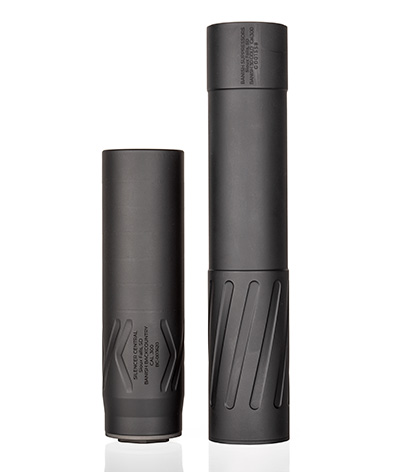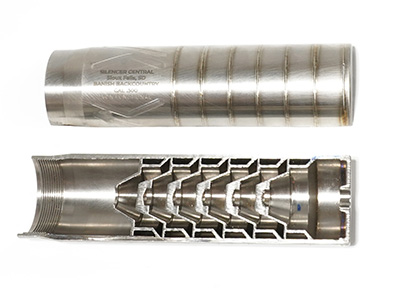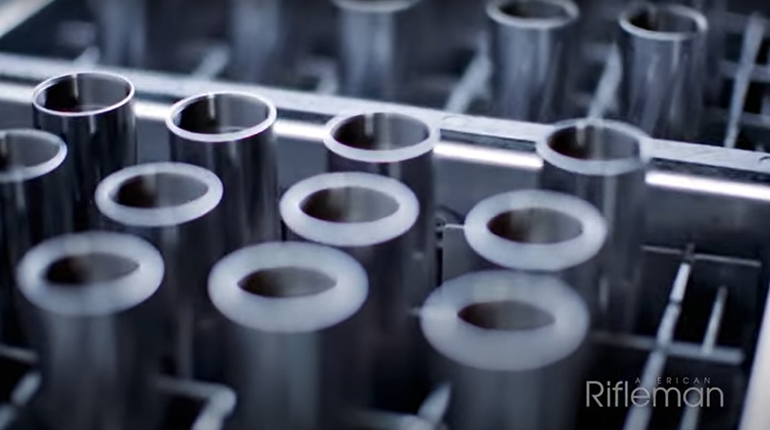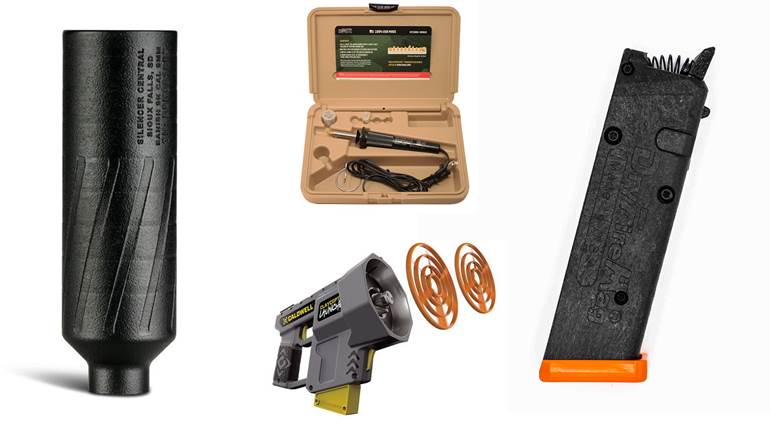
Owing to a suppressor of a given caliber’s ability to be used with an array of guns that fire bullets of that diameter or smaller—allowing, for instance, a .30-cal. silencer to be used aboard a 6.5 mm Creedmoor rifle or a 9 mm Luger pistol to run a .45-cal. handgun can—the suppressor is intrinsically a supremely versatile accessory. And until only recently, Silencer Central’s catalog of Banish suppressors had been built around highlighting that multi-caliber flexibility. Case in point, the last one that I evaluated here, the Banish 46, can be used with darn near any centerfire or rimfire cartridge of .46 cal. or less, making it compatible with thousands upon thousands of gun models, from .22 plinkers and home-defense carbines to semi-automatic pistols and safari rifles.

The Silencer Central Banish Backcountry (l.), while much shorter and lighter than the company’s Banish 30 Gold (r.), is still rated for up to full-power .300 RUM loads. Photo by Forrest MacCormack.
However, if designed with intent from the outset, a suppressor can instead be tuned toward a very specific specialized application. And now that Silencer Central has pretty much fleshed-out its lineup to the point that all the major bases are already covered (from a dedicated rimfire SKU on one end to the abovementioned rifle-rated Banish 46 on the other), the South Dakota-based company’s modus operandi regarding product development appears to have shifted a bit. Two of its most recent introductions, the Banish Backcountry and the Banish Speed K, instead cater to a pair of the silencer world’s more esoteric niches and deviate pretty substantially both from each other and the rest of the family as a result—although they do share an extreme emphasis on compactness. These two cans were both devised from conception to finished product to do exactly one thing and to do it well—it’s just that in the case of the new Banishes, those two things are about as far opposed from each other as suppressor end uses can be.
The Backcountry’s name gives it all away up front—it’s a .30-cal. featherweight hunting silencer intended for use on those long, hard treks across inhospitable terrain where civilization is hours or even days away and you don’t want to have to lug even a single ounce more than is absolutely necessary. It was built light and short enough that it can be hoofed up, down and across high country endlessly in pursuit of its quarry before (ideally) being used exactly once. The Speed K’s name is less self-explanatory; this one is a .223-cal. combat suppressor intended for hard, potentially high-volume use aboard a semi-automatic rifle, most likely for self-protection. And while it is currently being shopped around law-enforcement departments in search of procurement contracts, the can is, indeed, also being offered on the commercial defensive market as well.
Banish Backcountry
The Backcountry bears enough of the series’ hallmarks to be recognizable as a member of the Banish family, but also has enough differences to be distinguished as its own animal. To this point, all Banish suppressors have been constructed principally from titanium, a metal that is amazingly strong, durable and heat-resistant relative to its weight and density, if difficult to source and machine, which makes it just about perfect for use in a silencer. As a result, the entire line has always been comparatively lighter than most of the similarly sized competition on the suppressor market.

Christensen Ridgeline FFT with Banish Backcountry. Photo by Forrest MacCormack.
So, when the decision was made to focus on adding an especially ultralight member to an already lightweight line, Silencer Central sagely chose to stick with 100 percent titanium construction, from the one-piece body tube and six interior baffles to the direct-thread mount. Gone, however, is the ability of the user to disassemble the suppressor and remove its baffles for cleaning, heretofore a hallmark of the Banish series, as the Backcountry is the first model built around a more traditional sealed tube. Welding the baffles permanently in place allowed the company to remove unnecessary material and reduce weight by a few ounces—which was the point of this entire exercise, after all.
At just 5 5⁄8" long with a 1 5⁄8" diameter, the Backcountry is the shortest .30-cal. suppressor that I’ve ever encountered—beating most of its competitors by a margin of several inches—and the only (slightly) lighter ones that I can think of rely on the use of less durable aluminum to shave weight. For the sake of comparison, it stands a full 1 3⁄8" shorter than even the smallest configuration of its closest kin in the family, the modular Banish 30, and is only 1/4" longer than Silencer Central’s rimfire-only Banish 22.

A cutaway reveals the titanium Banish Backcountry’s baffle design, which seems to belie its 9-oz. weight. Photo courtesy of SilencerCentral.com.
At the same time, the Backcountry’s weight of 9 ozs. makes it 2.2 ozs. lighter than the shortened Banish 30 and a full 5.3 ozs. (59 percent) lighter than that can when it’s running all eight baffles. Yet despite its small size, the Backcountry is not lacking for ruggedness—as evidenced by its .300 Remington Ultra Magnum (Power Level III) maximum cartridge rating. Which means it can stand up to use on all the appropriately threaded .243 Win., 6.5 mm Creedmoor, .270 Win., 6.8 mm Western, 7 mm PRC, 28 Nosler, .30-’06 Sprg. and .300 Win. Mag. hunting rifles out there.
As far as a technical evaluation goes, there’s just not too much to say here: The Backcountry is simply a hollow tube with six M-type baffles welded to its circumference. Its construction is so simple, and its use is so one-sidedly beneficial, that it’s difficult to fathom that the government could feel the need to not only regulate its existence but also levy a sin tax to discourage its use. The Backcountry’s direct-thread mount uses the “universal” 1.375x24 TPI hub common to the suppressor industry, and the company offers it in five different thread pitches—although the preponderance of compatible hunting rifles will be threaded 5/8x24 TPI.
I saw this evaluation as an opportunity to test the Backcountry aboard an actual backcountry-hunting rig—my actual backcountry-hunting rig, in fact—a .300 Win. Mag.-chambered Christensen Ridgeline FFT. Doing so required the removal of the 2 3⁄8"-long, 3.4-oz. factory-mounted muzzle brake, so the practical impact of affixing the Backcountry to my rifle was a difference of only 3¼" and 5.6 ozs. Topped with an equally versatile Leupold VX-6HD 3-18X 44 mm, the total setup comes to only 7 lbs., 7 ozs.—totally manageable when hiking rough terrain and about as light as I would want a rifle with this much juice to be.
Due to an often-quoted but usually profoundly misunderstood figure used by the Occupational Safety and Health Administration, there is a belief by some members of the suppressor community that any sound of less than 140 dBs is “hearing safe” and thus not requiring of ear protection—which simply ain’t so. For the sake of your long-term hearing, this misconception needs to be put out to pasture. During my testing with the 22"-
barreled Ridgeline FFT and Browning’s 180-grain BXS load, using a Larson Davis LxT1 sound meter, the Backcountry nonetheless did manage to limbo just under that threshold, garnering a five-shot average volume of 139.28 dBs. Compared to the 160.78-dB baseline using only the rifle’s bare muzzle, this equates to a substantial 21.50-dB reduction. Frankly, this is more than I expected out of a suppressor that intentionally forgoes so much volume for the sake of maximized portability.
However, as I see it, the chief value of the Backcountry is in its recoil reduction—which was dramatic. The natural consequence of removing as much weight as possible from a rifle is that it gets back at you by kicking the snot out of you with each pull of the trigger, and my Christensen is a teeth-rattler, even with the factory brake, that I don’t typically shoot beyond what is absolutely necessary. I have no way to quantify the reduction, but the Backcountry took a rifle that was not particularly fun to shoot and tamed it to the point that regular practice is something to look forward to—which is pretty much the entire reason for cutting recoil at all.
Theoretically, the lighter a suppressor is the less impact its presence should have on the point of impact of its host rifle once affixed to its barrel, and the Backcountry seemed to bear this premise out—although more on this later. Five shots fired through the silencer at 100 yards landed only about one inch up and the same amount left of the five fired without it. This was minimal enough that only an extra shot or two should be necessary to re-adjust your zero when switching back and forth.
In all, between its compact size and impressive performance mitigating both sound and recoil, the Banish Backcountry strikes an ideal balance of being small enough that you won’t mind its presence, but large enough to do its job well. Where ounces are pounds and pounds are pain—and each additional inch is exponentially more likely to get snagged on brush—the Backcountry is “worth its weight in gold.”
Banish Speed K
When it first set up shop, Silencer Central’s initial concern was with making and selling hunting suppressors, and the catalog still skews sharply in that direction. So, when the company decided to diversify by building its own dedicated fighting can for use aboard a gas-powered, .223 Rem./5.56 NATO-chambered carbine, it sought out the feedback of more than 20 law-enforcement professionals—including city police, state troopers and SWAT personnel—for guidance into what mattered most to them in a tactical silencer.
These peace officers overwhelmingly had two priorities: effective management of the increased back pressure inherent to suppressor use and a shortened form factor that optimizes maneuverability. Silencer Central’s goal then became to design an accessory that balanced these two concerns while still offering as much sound mitigation as possible. The resulting Speed K is the most different suppressor that the company has ever produced—as it’s not just the “why” of its construction that is entirely divergent from that of the rest of the hunting Banishes, but also the “how.” This is the first of the company’s designs to be built using additive manufacturing techniques and a 3D printer.

S&W Volunteer XV Pro with Banish Speed K. Photo by Forrest MacCormack.
To what end? Primarily to better limit the amount of post-shot waste materials re-entering the rifle. Gas being blown rearward back up the barrel is a natural consequence of using a suppressor, which can constitute a major hindrance when the user is shooting a semi-automatic design. Not only does this greatly increase the amount of ignition debris accumulating within the action—hastening wear and reliability issues—but a portion of this gas is often also then expelled out the ejection port and at the shooter. This is even more of an issue for southpaws using right-ejecting guns. The last thing a cop (or a home-defender) should have to worry about when clearing a building (or their own domicile) of threats is the need to squint through tears because he or she got blasted in the face by their own gun’s waste byproducts in a case of self-inflicted “friendly fire.”
By building the suppressor layer by layer—0.2 mms at a time—the Speed K could be designed with internal geometries and additional pathways to significantly reduce this back pressure that wouldn’t have been cost-effective, or in some cases possible at all, through traditional manufacturing. Additive manufacturing also allows the suppressor to be made without welds, which simplifies the building process and (thanks to sensitive software that individually inspects each layer of the print cycle) reduces the likelihood of a manufacturing defect. However, as with the Backcountry above, the Speed K is not user-disassemblable for easy cleaning—which I have found to be a valuable feature of the Banish line in the past.

The Speed K measures only 4" in overall length and 2" in diameter, which helps to preserve the compact, lightweight form factor of its host semi-automatic carbines. Photo by Forrest MacCormack.
A five-baffle design, the first two chambers of the silencer work to disperse energy as quickly as possible through the use of a finned blast chamber. The remaining three baffles are then designed to control the flow of the ignition gases through the suppressor, slowing them down and forcing as much of the hot gas forward as is possible before it exits the device. Moving away from titanium for the first time ever, the Speed K is built in its entirety from Inconel 718, a highly corrosion-resistant nickel-chromium alloy with an excellent yield strength at high temperatures. This makes it an ideal material for use in high-volume suppressors, and the Speed K is rated for full-automatic fire (through carbines with barrels of at least 10.3") as a result.
Which brings us to the second design priority: compactness. Remember back when I said the Backcountry was especially short? Well, the Speed K heard that and said, “Hold my beer.” The squat little can measures just 4" in length but with a girthy 2" diameter. This makes it not much longer than most of the blast shields and linear comps already used on many defensive carbines, while being far more functional—but the silencer is fat enough that it isn’t going to be slipping under a free-floating handguard anytime soon.
However, it can’t be called light; our test unit came in at a hefty 15.9 ozs., 4.5 ozs. heavier, but 3" shorter, than the similarly calibered Banish 223. Fortunately, the weight of the silencer was kept reasonable enough that, when attached to the Smith & Wesson Volunteer XV Pro host rifle for range testing, it did not give the AR-15-style carbine an unwieldy, nose-heavy feel—yet its truncated length will be appreciated when maneuvering cramped interiors or pieing a doorway. The can comes with a direct-thread mount in one of six thread pitches, including 1/2x28 TPI, the industry standard for .22-cal. rifles.

The Speed K literally fits in the palm of the hand (l.), and weighs less than 1 lb., yet its stout construction allows for fully automatic fire. Removing the direct-thread mount (r.) reveals the can’s distinctive finned blast chamber. Photo by Forrest MacCormack.
For a suppressor claiming to cut back pressure substantially, I can assure you from years of personal experience that a left-handed evaluator shooting a right-ejecting gun serves as the ultimate test. If there’s gas blowback to be found, my face will find it. The results through the S&W M&P 15 using Hornady’s 55-grain V-Max .223 Rem. load were just shy of perfect.
During slow fire for the sound-meter testing, I could not discern any gas striking my face at all. However, by the end of a rapid-fire mag dump, I could tell that my eyes were starting to become slightly misty. Coming from a southpaw, this is actually exceptionally high praise, and it represents a far cry better experience than the debilitating salvo to the face that right-ejecting guns with a typical suppressor pelt left-handed shooters with after each and every pull of the trigger. To get the right-handed perspective, I briefly switched shoulders for a few shots, and I encountered no gas at all, so righties should be good to go. “Internal geometries” for the win.
Suppressors cut recoil and weight cuts recoil, so the Speed K couldn’t help but cut recoil—enough so that it was noticeable even aboard a host as naturally soft-shooting as a gas-powered .223 Rem. Between the decreased kick and the decreased report, rapid-fire strings of fire were blessed easy to keep on target at room-clearing distances. The silencer also demonstrated that the old theory about weight causing point-of-impact shift is overly simplistic, as the chunky Speed K caused essentially zero along either axis at 25 yards.
Functioning of the nonadjustable direct-impingement rifle was not impacted negatively at all by the presence of the can—it ran 100 percent when suppressed. The difference in muzzle blast between the naked barrel and the suppressed one was night and day—figuratively and almost literally. This is another important consideration for the armed citizen who will most likely be called to action during the overnight hours.
As substantial as the effects of a silencer are when used outside, the tendency of sound waves to reverberate against walls and furniture makes their benefits even more keenly felt when used indoors. And while sound mitigation was a tertiary concern for Silencer Central in the creation of the Speed K, it still performed admirably well in my testing with the Larson Davis sound meter. Five readings taken 6" from the shooter’s ear averaged 155.82 dBs unsuppressed and 137.90 dBs after the installation of the Speed K, for a reduction of 17.92 dBs.
I think it’s safe to say that Silencer Central achieved what it set out to accomplish with the new Speed K. Unobtrusive in size yet effective in minimizing gas blowback, the suppressor would serve law-enforcement officers who wear hearing protection as a standard operating procedure extremely well. And on the home-defender side of the equation, it could also be a decisive difference-maker: If you’ve never experienced it, between the thunderous noises and blinding flashes, firing a defensive carbine inside a structure at night is especially disorienting—and you will almost certainly be called to so during a circumstance when you’d best have your wits about you.
In this type of life-or-death scenario, a combat suppressor like the Speed K can help greatly to reduce the pandemonium of a defensive encounter—providing a substantial tactical advantage that just might save the lives of you and yours. Plus, once all is said and done, while unprotected exposure to 138-dB sounds within the tight confines of a building is still going to be brutal on your ears, it pales in comparison to the lasting damage that an unsuppressed 156-dB rifle would have wrought on your hearing.






































